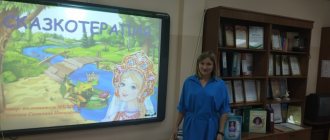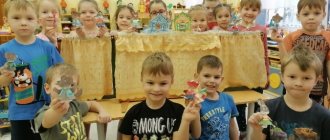Theatrical activities as a means of comprehensive development of preschool children
When I engage in theater with children, I set myself the goal of making our children’s lives interesting and meaningful, filling it with vivid impressions, interesting activities, and the joy of creativity.
In the process of teaching, I solve the following tasks:
development of children's speech and fine motor skills;
formation of communication skills;
development of creative abilities;
identifying children's talents;
developing the ability to interact with others;
formation of the sensitive-emotional sphere;
manifestation of a sustainable interest in fiction and books;
education of aesthetic taste;
development of such personal qualities as determination, will, initiative and others.
My students’ first introduction to the theater was through their acquaintance with the puppet theater. The conventions of puppet theater are close and accessible to children; they are accustomed to it in their games. That’s why children get involved in the play so quickly: answer the dolls’ questions, carry out their instructions, give advice, warn about danger and provide assistance to the characters in the play. Also, in the younger group, at first I independently show the children a dramatization of the fairy tale, and involve the children in reciting its individual fragments. I use small exercises with children, after the end of the theatrical game, I invite the children to play the same way, for example, in the fairy tale “Teremok” you need to ask to go into the tower, like a mouse and like a wolf.
I started using theatrical performances with children from middle age. Preschoolers happily depict the habits of animals in small scenes, imitating their movements and voices. In the reflection of fairy-tale images of animals, the nature of movement and intonation are analyzed: a hen or a little chick is walking, happy or sad hares, leaves are spinning, falling to the ground. They also perform psycho-gymnastics exercises: it’s raining, the wind is blowing, the sun is out, a cloud has rolled in. To develop plastic expressiveness, she offered children:
Walk on pebbles across a stream on behalf of any character (fairy tale, short story, cartoon) of their choice.
On behalf of any character, sneak up on a sleeping animal (hare, bear, wolf).
Depict a walk of three bears, but in such a way that all the bears behave and act differently.
When working on acting skills, I use a sketch simulator and give tasks to show: a cowardly hare, a fox listening, delicious candy, a prickly hedgehog, a sleepy bear, etc. Children especially like exercises for the development of expressive facial expressions: salty tea, eating lemon, angry grandfather, the light bulb has gone out , lit up, dirty piece of paper, warm - cold, angry at the fighter, offended, I’m sad, show how the cat begs for sausage. I also suggest that children act out small scenes where it is necessary to emphasize the peculiarities of the situation with facial expressions. For example, depict how a boy was given a new car or how a child was scared of a bear.
Content
Introduction
.
THEORETICAL FOUNDATIONS FOR STUDYING THE DEVELOPMENT OF INTONATIONAL EXPRESSIVENESS OF SPEECH THROUGH THEATER ACTIVITIES IN PRESCHOOL CHILDREN
1.1
Scientists' views on the development of intonation expressiveness of speech
1.2
Characteristics of the intonation-expressive side of speech
.3
Features of the development of intonational expressiveness of speech in preschoolers in ontogenesis
1.4
Characteristics of theatrical activities in working with preschoolers
.5
Features of working with literary material in theatrical activities
2.
EXPERIMENTAL STUDY OF THE DEVELOPMENT OF INTONATIONAL EXPRESSIVE SPEECH IN PRESCHOOL CHILDREN
2.1
Purpose, objectives, research methods. Ascertaining experiment
2.2
Analysis of the results of the ascertaining experiment
2.3
Experiential learning. Analysis and processing of experimental results
Conclusion
List of used literature
Application
Introduction
intonation theatrical speech preschooler
Relevance
Our research is due to the fact that intonation is an important meaning-distinguishing means of language, thanks to which we express various communicative goals, which must be formed in preschool age. A delay in the formation of intonation expressiveness of speech at the time of schooling makes it difficult to master the program in the native language and can lead to a violation of the communicative function of the language.
One of the little-studied areas is the use of theatrical activities in order to develop intonational expressiveness of speech in preschool children.
With the help of means of intonation expressiveness, clarification of thoughts and expressions, as well as emotional-volitional relationships, is carried out in the process of communication. the thought acquires a complete character, the statement may be given additional meaning without changing its basic meaning, and the meaning of the statement may also change [1].
In normal children, just like their peers, violations of intonation expressiveness of speech are detected. In this regard, the object, subject, hypothesis, purpose and objectives of the study were identified.
An object
research - the process of developing intonation expressiveness of speech in preschoolers through theatrical activities.
Item
research - means of theatrical activities for the development of intonation expressiveness of speech in preschool children.
Hypothesis.
We hypothesized that the development of intonation expressiveness of speech in preschoolers will be successful if:
·classes in theatrical activities will include a set of exercises, games and sketches for the development of intonation, timbre, pitch and strength of voice, tempo, pause, rhythm, logical stress, speech breathing;
·selected and compiled artistic speech material for the development of intonational expressiveness of speech;
· an artistic and aesthetic developmental environment has been created that allows the child to independently realize his creative potential in theatrical activities.
Purpose of the study
— to develop and test the use of theatrical activities in the development of intonational expressiveness of speech in preschool children.
The following tasks
:
1) Study psychological, pedagogical, methodological literature devoted to the development of intonational expressiveness of speech in children 6-7 years old through theatrical activities;
2) To study the nature of the impact of theatrical activities on the development of intonational expressiveness of children’s speech;
3) To study the state of intonation expressiveness of speech in preschool children;
4) Experimentally test the effectiveness of improving the development of intonation expressiveness of preschoolers’ speech using theatrical activities.
Methods
conducting research:
1) Organizational methods (comprehensive and comparative);
2) Imperial methods (conversation, ascertaining and formative experiments);
)Qualitative and quantitative analysis of the data obtained;
)Graphical methods (presentation of results).
Practical significance
consists in the complex of artistic speech means we have developed for mastering the skills of intonation expressiveness of speech through the method of artistic reading. This complex can be useful for speech therapists, special teachers and educators in the system of general, special and additional education of preschool children.
Scientific novelty
determined by the fact that the features of the development of intonation expressiveness of speech of preschoolers aged 6-7 years have been identified; The content and methods of developmental work on the formation of intonation expressiveness of preschoolers have been determined and tested.
Methodological basis
research amounted to:
general didactic provisions on the formation of skills (L.S. Vygotsky, L.A. Leontiev)
works of scientists in the field of speech disorders ();
research on the problem of studying intonation-expressive means in preschool children (E.E. Artemova, E.F. Arkhipova, L.R. Zabrodina, L.A. Kopachevskaya, L.A. Pozdnyakova, A.N. Polozova, E.E. Shevtsova);
technology, the use of theatrical activities for the development of speech culture in preschool children (A.I. Burenina, O.V. Goncharova, E.V. Migunova, E.G. Churilova).
The defense is based on the proposition that the complex of speech means of theatrical activities influences the formation of intonational expressiveness of speech in preschool children.
The structure of the final qualifying work includes an introduction, two chapters, a conclusion, a bibliography of 40 sources and 6 appendices.
1. THEORETICAL FOUNDATIONS FOR STUDYING THE DEVELOPMENT OF INTONATIONAL EXPRESSIVE SPEECH THROUGH THEATER ACTIVITIES IN PRESCHOOL CHILDREN
.1 Views of scientists on the development of intonation expressiveness of speech
The history of the development of special studies of intonational expressiveness in linguistics can be divided into two periods. The first - from the end of the 19th to the beginning of the 20th century - is characterized by the search for an object of study and methods for its analysis. In the second period, from the 40s of the 20th century to the present day, there was an expansion of intonation research associated with the development of both linguistic theory and the technique of instrumental phonetics. [26p]. In addition to studying intonational expressiveness as a set of suprasegmental units, researchers analyze its individual components. The works of L.V. are of greatest importance for the theory of intonation. Bondarko, E.A. Bryzgunova, V.V. Vinogradova, A.M. Gvozdeva, L.R. Zindera, L.V. Zlatoustova, T.M. Nikolaeva, N.D. Svetozarova, I.T. Torsueva, L.K. Tseplitis, N.V. Cheremisina, L.V. Shcherby.
As a phonetic phenomenon, intonation expressiveness is considered in various aspects: articulatory, acoustic, perceptual, linguistic [26].
The study of intonation expressiveness in the articulatory aspect involves identifying the work of the speech organs.
The study of intonational expressiveness in the acoustic aspect considers speech as the oscillatory movements of an air stream affecting the human hearing system, which manifests the objective characteristics of intonation: fundamental frequency, spectrum, intensity and duration (Ya.P. Altman, A.V. Ventsov, G. V. Gershuni, L.A. Chistovich)
The study of intonational expressiveness in the perceptual aspect involves the study of those correspondences to the objective characteristics of intonation, thanks to which a person perceives this or that meaning conveyed by intonation. Sound sensations that correlate with the objective characteristics of intonation expressiveness are height, duration, volume, timbre (Vakhtina N.Yu.) [2].
In the linguistic aspect, intonation expressiveness is understood as a complex unity of melodic, dynamic and temporal characteristics of speech. Each of these parameters has its own specific units - carriers of meaning: tonemes, chronemes, accentemes (Nikolaeva T.M.) [3].
The independence of intonation from the specific lexical and grammatical composition of the utterance allows us to talk about its relative autonomy. The works of L.V. are of great importance for the theory of intonation. Bondarko, E.A. Bryzgunova, L.P. Blokhina, L.R. Zindera, L.V. Zlatousova, T.M. Nikolaeva, N.D. Svetozarova, N.S. Trubetskoy, L.D. Shcherba, who developed the concept of supersegmental organization of speech as a system. The prosodic organization of speech is understood as a set of sound means that form sequences of segmental units (phonemes) and serve to combine them into meaningful linguistic units: words, syntagms, statements. The use of such obligatory sound features as duration, intensity and frequency of the fundamental tone as prosodic characteristics of speech is one of the universal properties of human speech (N.D. Svetozarova) [5l].
N.I. Zhinkin, considering the prosodic organization of language, Fr. The researcher calls the control of these parameters during speech prosody. And the realized set of these parameters is intonation [18].
E.A. Bryzgunova, analyzing the relationship between the components of intonation, argues that logical stress is formed in speech by a combination of these components, since at logical centers the voice changes in pitch, strength, tempo, and timbre [7].
The question of the nature of the units involved in the intonational design of an utterance was examined in detail by L.V. Shcherba, who noted that the connection between the semantic and sound aspects of speech is carried out within the simplest syntactic whole - syntagma, a single semantic whole in the process of speech - thought.
I.G. Torsueva, using a semantic approach to identify rhea units, identifies statements. The main characteristics of an utterance are its communicative orientation, targeting, the possibility of semantic division, emotional richness, and the presence of subtext. Unlike a sentence that has meaning, a statement, in addition to meaning, has a specific holistic meaning, it has authorship and an expressive side [5].
The intonation of each phrase is the result of the interaction of many factors, the most important being: the communicative attitude of the speaker, his reflection of the communication situation, the universal physiological foundations of speech production.
The most emotional phrases are such as “exclamation”, “command”, “implication”, phrases like “general and special question” have a lower degree of emotionality, and a weak degree of emotional intensity is characteristic of simple statements and phrases.
L.V. Bondarko identifies several factors that determine the behavior of all components of intonation: “... the place of the main stress in the syntagm is important: it is in this place that the most significant change in melody occurs - a decrease or increase. The direction of change itself is determined by the type of intonation (narration, question, unfinished intonation, exclamation). Changes in tempo and volume are also associated with the place of the main stress: if it is close to the end of the syntagma, then the tempo slows down more significantly, and the volume is weakened less than in the case when the syntagmatic stress is close to the beginning of the syntagma [9].
1.2 Features of the development of intonation expressiveness of speech in preschoolers in ontogenesis
Intonation expressiveness of speech represents the totality of rhythmic and intonation properties of speech. The intonation-expressive side of speech is realized through such qualities of speech as timbre, pitch and strength of voice, tempo, pause, rhythm, logical stress, speech breathing, diction. Prosodic components determine the expressiveness, intelligibility of speech, its emotional impact in the process of communication, carry a certain semantic load, etc.
The concept of intonation includes the rate of speech (the degree of speed of pronunciation of speech elements), pauses (breaks in the pronunciation of speech elements), the timbre of speech (the color of the human voice), the tone of speech (the degree of pitch), melody (alternating raising and lowering of the voice, logical stress and word stress) [32].
Rate of speech is the most important component of intonation. Tempo is the speed of pronunciation of speech elements. The pace of speech may vary. This depends on the content of the statement and the emotional mood of the speaker [38].
Pathologically fast speech (tachylalia) requires increased attention, which causes fatigue. Pathologically slow speech (bradylalia), on the contrary, weakens attention, which also leads to fatigue.
The rate of speech depends on the age of the speaker. The pace of speech is determined by the content of the text.
The individual component of intonation is the timbre and color of the voice. Each person has their own timbre. The timbre of the voice can change, depending on the emotional state of the person and the time of day. The timbre of the voice can be varied, and its perception is always subjective.
Pauses occupy a special place in intonation - this is a “non-sound” intonation device. Pauses are necessary because they break the flow of speech, making speech easier to perceive. Intonation-logical pauses separate one speech beat from another and help clarify their meaning. If you do not make a logical pause, you will end up with a continuous text in which it is difficult to make out which words in a sentence are closely related in meaning and combined intonationally. There is a semantic pause (logical), determined entirely by syntax, and a rhythmic pause, independent of syntax and determined by a rhythmic impulse. The first is present in every speech, the second - only in poetry. The duration of pauses and the nature of their distribution in the speech stream largely determine the rhythmic and melodic side of intonation.
The strength of the voice depends on how the sounds of the voice are directed into the resonators and what state they are in. Loudness is ensured by good functioning of the breathing apparatus, active articulation, and the absence of unnecessary muscle tension. When the strength of the voice is impaired, it becomes dry, weak, or too loud. Voice strength is an objective quantity; it is the real energy of sound, measured in decibels. The strength of the sound depends on the amplitude (span) of vibration of the vocal cords, the degree of their tension, as well as on the activity of the resonators (oral and nasal cavity). The volume of a voice depends on its strength. But if the strength of the voice is an objective value, then loudness is a subjective concept associated with our perception of sound. Volume is the controlled quality of the voice. It can and should be changed depending on various circumstances of communication. Flexible change in voice volume is a means of achieving expressiveness of speech, its diversity, and adequacy of the communication situation [17].
Voice pitch is a physiological property of the speaking voice, controlled by the tension of the vocal folds and the frequency of their vibrations. It is characterized by organizational breathing and the active work of resonators that amplify sound. If the pitch of the voice is impaired, it becomes monotonous, tremulous, tremulous, inexpressive, unmodulated, and sometimes falsetto-like [31].
Rhythm is a natural repetition of commensurate and sensually perceptible units. Rhythm in a broad sense is inherent directly in a number of natural phenomena and the human body (rhythmic breathing, heart function, blood circulation, etc.) [19].
The basis of the rhythmic organization of human speech is that natural, primary rhythm that characterizes the activity of the human body and, in particular, human breathing. Since the breathing process is relatively rhythmic, human speech is also rhythmic to a certain extent: the need for periodic inhalation and exhalation causes corresponding stops in the voice - pauses, which break speech into units called speech beats. Thus, the unit of speech rhythm becomes a word or a group of words, limited from subsequent ones by a pause.
Logical stress is the selection of the most important word among the others to convey the exact meaning of the sentence. Logical is recognized as a semantic stress that is emphasized as strongly as possible, clearly highlighted intonation (by strength and a significant interval of pitch compared to ordinary verbal stress). The specificity of logical stress is in the special semantics and in the degree of emphasis of the accented word. Consequently, the means of expressing logical stress are: strengthening verbal stress, raising or lowering the tone on the stressed syllable of the highlighted word, increasing the duration, which is achieved by increasing the tension of the articulation of the stressed syllable [27].
Speech breathing is the basis of sounding speech, the source of the formation of sounds and voices. It ensures normal voice formation, correct assimilation of sounds, can change the strength of their sound, helps to observe pauses correctly, maintain fluency of speech, change volume, and use speech melody. The correct use of breathing in speech consists, firstly, in the economical and uniform consumption of air, and secondly, in the timely and imperceptible filling of its supply (during pauses).
In normal speech, fluency is organically combined with pauses, which are a necessary component of a speech utterance [8].
Diction - The basis of clarity and intelligibility of speech. Clarity and purity of pronunciation depend on the active and correct functioning of the articulatory apparatus: tongue, lips, palate, lower jaw and pharynx.
1.3 Features of the development of intonation expressiveness of speech in preschoolers in ontogenesis
According to Zhinkin, intonational expressiveness of speech is the highest level of language development. Prosodic manifestations can be noted already in children during infancy [20].
The initial stage of pre-speech development is considered to be the child’s reflexive cry, which by 2-3 months of life becomes increasingly modulated and reflects various shades of dissatisfaction, thereby being a means of communication with others. Up to two months, vocal expressions are differentiated due to different voice intonations (screaming, crying), but crying no longer receives more detailed differentiation, since after two months the sounds are differentiated. In combination with expressive facial movements, an intoned cry and modulated sounds are a means of expressing the child’s state. R.V. Tonkova-Yampolskaya points out that during a child’s cry, specific areas of the cortex are activated. The child hears his cry, impulses reach the auditory-speech and speech-motor zones of the cortex, and from here they are transmitted to the organs of articulation, gradually giving them an impetus for development.
At 2-4 months, the baby begins to make short sounds - hooting, and then humming. The sounds do not carry any semantic content, but have a certain intonation, with their help the child attracts the attention of an adult. First of all, children learn and convey the types of intonation that are most often used by adults. The sounds of humming become a means of communication with adults due to their intonation expressiveness, starting from the end of the third month of life, when the sounds of humming become quite distinct in intonation [35].
The most intense process of accumulation of babbling sounds occurs after the sixth month during the seventh month, then the process of accumulation of sounds slows down and few new sounds appear. The process of intensive accumulation of sounds in babbling coincides with the period of myelination, the significance of which lies in the fact that its onset is associated with a transition from generalized movements to more differentiated ones. From 7-8 months to one year, articulation does not expand particularly, but speech understanding appears. During this period, semantic load is received not by phonemes, but by intonation, rhythm, and then the general outline of the word. Communication is carried out using emotional intonation. At about 11 months, active babbling chains of syllables appear. In this case, any syllable is distinguished by its duration, volume, and pitch. Most likely, this is the initial stage of stress formation.
Ontogenesis data indicate that intonational means are perceived and assimilated by children much earlier than the formation of verbal speech begins. Tonkova-Yampolskaya's research showed that the process of mastering the intonation system of a language begins in a child already at the humming stage. Gvozdev notes that the child uses lowering intonation to express a calm statement already during the period of a one-word sentence. Around the same time, varieties of exclamatory intonation appear, and in the second year of life, interrogative intonations appear [5].
Manifestations of intonational expressiveness of speech, expressed in the form of emotionally expressive vocalizations, are a prerequisite for the child’s language development.
The intonation expressiveness of speech includes several acoustic components: tone of voice, its timbre, intensity or strength of voice sound, melody, pauses, verbal logical stress, tempo of speech. These acoustic characteristics of intonation expressiveness of speech depend on the frequency and amplitude of vibration of the vocal cords, on the degree of muscular tension of the speech organs, on the different speed of change of articulations, and on emotional tone.
The intonation expressiveness of speech increases the volume of the message, communicating not only what is contained in the text, but also what is in the subtext. The anatomical and physiological nature of the intonation expressiveness of speech consists of speech movements, which are based on modulations of the pharyngeal tube, affecting the power of sound speech (Zhinkin) [19].
The intonation expressiveness of speech clarifies the semantic side of speech, reveals its emotional content and has a strong impact on the listener. Intonation organizes the semantic side of speech with the help of logical intonations - narration, enumeration, highlighting stressed words, changing the tempo of speech.
The baby's reactions to the tone of voice appear quite early: at 4 months the child listens to the voice of an adult, reacts with a smile, laughter, humming, may become wary and cry, that is, adequately reacts to the tone of an adult.
The perception of intonation is noted in children earlier than reproduction. This is due to the fact that the intonation field of the speech-auditory analyzer (perception of intonation) ends its formation by the end of the babbling period, while the formation of the intonation field in the speech-motor analyzer (reproduction of intonation) ends only during the formation of oral speech.
A classification of types of intonation expressiveness of speech was proposed by A.K. Tseplitis and identified the following [36]:
. Intelligent
. Voluntary
a) narrative
b) incentive
. Emotive
. Fine
The meaning of intellectual types of intonational expressiveness of speech represents the moments of mental activity reflected in the language associated with the generation of statements: a statement (transmission of information) or a question (expression of a desire to receive information).
Voluntary meanings of intonation expressiveness of speech belong to the sphere of human speech activity. There are two groups of voluntary intonation:
a) narrative - the intonation of a statement in statements of fact or judgment, but not intonationally expressing the will or emotional state of the speaker; the intonation of advice, but without compulsion to carry it out;
b) incentive types of intonation: intonation of an order; intonation of request.
Emotive intonation is the expression of emotions by intonation means: anger, fear, tenderness, sadness, indifference, shame, surprise.
Fine types of intonation expressiveness of speech serve to reproduce the physical properties of a phenomenon or object. The semantics of these types of intonation expressiveness is associated with such mental processes as perception, sensation, imagination. For example, to communicate something big, a low range of voice is used, i.e. low frequencies and a slow tempo, and the high range of the voice is used to characterize something small.
Melody is the main component of intonation expressiveness of speech and provides a rise and fall in the tone of the voice. Phonetic melody, combined with stress and pauses, forms the semantic relationships between parts of the phrase. Russian speech is characterized by four types of melody according to the direction of tone movement: descending melody, ascending melody, ascending-descending melody, even melody.
.4 Characteristics of theatrical activities in working with preschoolers
Theatrical activity is an activity that is unusually emotionally rich, which makes it attractive to children. It brings great joy and surprise to the child. It contains the origins of creativity; children accept the guidance of an adult without noticing it. Being a syncretic activity in nature, it most fully embraces the child’s personality and meets the specifics of the development of his mental processes: integrity and simultaneity of perception, ease of imagination and faith in transformations, emotional sensitivity, not only figurative, but also logical thinking, motor activity, etc. P. (L.V. Artemova, L.S. Vygotsky, N.F. Sorokina, L.G. Milanovich, D.B. Elkonin, etc.). This indicates the broad developmental potential of theatrical activities.
There are many types of theatrical activities, differing in artistic design, and most importantly, in the specifics of children's theatrical activities. According to the classification of L.S. Furmina are objective (the characters are objects: toys, dolls) and non-objective (children in the image of the character perform the role they have taken on) [18].
Theatrical activity researcher L.V. Artyomova divides into two groups: dramatization and directorial activity [5].
Goncharova O.V. identifies the following forms of theatrical activity:
performances;
theatrical games;
dramatization;
musical and dramatic performances.
At the heart of a dramatic performance
lies a literary work - a play







